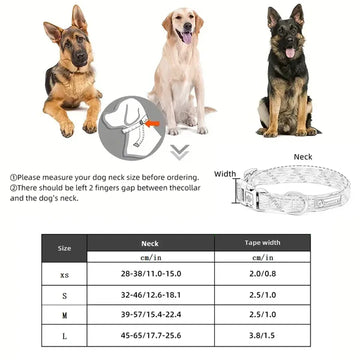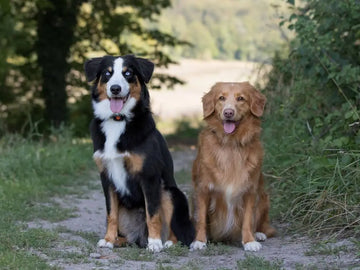A dog collar should fit snugly but comfortably around the dog's neck to ensure both safety and comfort. The general rule of thumb is that you should be able to fit two fingers between the collar and your dog's neck. This allows for enough room to prevent chafing, while also ensuring that the collar won't slip off or cause discomfort. When selecting collars and other pet supplies, such as the best puppy collars, it's important to choose items designed specifically for your dog's breed and age.
Measuring the Dog’s Neck Size
The first step in ensuring a proper fit is to measure your dog’s neck. Use a soft measuring tape and wrap it around the base of the neck, where the collar will sit. Make sure not to measure too tightly; it should be a comfortable measurement where you can still fit your fingers in between the tape and the dog’s skin. Once you have the measurement, add about 1-2 inches to ensure that the collar can be adjusted to fit snugly.
For puppies, it's a good idea to select collars that are specifically designed for their size and growth stages. The best puppy collars are typically adjustable and made from soft, comfortable materials to ensure they won’t irritate a puppy’s sensitive skin. Puppies grow quickly, so you’ll need a collar that can grow with them without compromising comfort. Collars that are too tight can be painful for young dogs, especially as they experience rapid growth, while collars that are too loose can slip off or cause discomfort.
Types of Collars and Adjustability
Different types of dog collars may fit differently. The two most common types are buckle collars and slip collars.
-
Buckle collars are the most traditional and are easy to adjust. These collars usually feature a metal or plastic buckle and can be loosened or tightened with holes similar to a belt. A buckle collar is a versatile choice for most dogs and is easy to find in different materials and styles.
-
Slip collars (like martingale collars) are designed to tighten when pressure is applied, making it more difficult for a dog to slip out of the collar. These collars are adjustable but should be sized correctly to avoid choking. Slip collars are often used for training, especially for dogs that pull or are difficult to control. However, they should be used with care, ensuring they’re not too tight, as excessive tightening can cause discomfort or harm.
If you're concerned about neck pressure or pulling, consider opting for a puppy harness instead of a collar. A harness can distribute pressure more evenly across the dog's body, reducing strain on the neck. This is especially beneficial for puppies, who are still developing physically and can be more susceptible to injury. Harnesses are also great for dogs that tend to pull on the leash or for those with respiratory issues, as they avoid putting pressure on the neck.
Regardless of the type of collar or harness, it's important to ensure the collar is adjustable to allow for changes in the dog's size as it grows or loses weight. Puppies, in particular, experience rapid growth, and an adjustable collar is ideal to accommodate this. Regularly check your dog’s collar for any signs of tightness or looseness, especially during periods of growth or weight fluctuations.
Signs of a Proper Fit
When fitting a collar, it should sit just below the dog's ears and near the base of the neck, but not too high on the throat. There should be enough room for two fingers to fit between the collar and the dog’s neck, which is an ideal fit. The collar should not be tight enough to cause discomfort, but it should also not be so loose that it can slip over the dog's head.
If the collar is too tight, it may cause irritation, restrict breathing, or cause the dog pain, especially if the collar is made of stiff material. If the collar is too loose, it can slide off easily, or your dog could potentially get caught on something during play or walks, which could lead to injury.
Additionally, check for any signs that your dog may be uncomfortable with the collar. This might include frequent scratching or pawing at the collar, or if the dog seems to be avoiding wearing it. If your dog shows any signs of discomfort, it's important to check the fit and adjust it accordingly.
Adjusting the Collar as Your Dog Grows or Gains/Losers Weight
A collar that is too tight can be painful for a dog, especially if they are growing or if their weight fluctuates. Puppies, for example, often outgrow their collars quickly, so it is essential to check the fit regularly and adjust it as necessary. For adult dogs, monitoring their collar fit is important to prevent it from becoming too tight due to weight changes. If your dog gains or loses weight, the collar should be adjusted to maintain a proper fit.
For dogs with thicker fur, such as Golden Retrievers or Huskies, it’s essential to ensure the collar is still snug but not too tight, as the fur can sometimes create a buffer that hides how tight the collar really is. Always check under the fur to ensure the collar isn’t too tight and is sitting properly around the neck.
Collar Materials and Comfort
The material of the collar can affect both its fit and comfort. Soft, breathable materials like nylon or leather are typically good choices, but they should still have some flexibility. Avoid collars made from materials that could irritate the skin, like rough leather or stiff plastics. Some collars also come with padding, which can help improve comfort, especially for dogs with sensitive skin or those who wear their collars for long periods of time.
Choosing a collar that is soft but durable ensures that it can withstand regular wear and tear, especially for active dogs who spend a lot of time outside. Reflective collars or those with built-in ID tags are also a good choice for safety, especially if you walk your dog in low-light conditions.
Importance of Regular Collar Checks
Even if your dog's collar fits well at first, it's important to check it regularly. Collars can get stretched out over time, and your dog’s neck may grow or shrink due to weight changes, growth (in puppies), or health conditions. A collar that starts off well-fitted might become too tight or too loose after some time, which is why periodic checks are crucial.
If you notice signs that the collar is too tight or too loose, such as redness, hair loss, or difficulty breathing, it's time to adjust it or replace it. If the collar is too tight, you may also notice your dog constantly scratching at the collar or trying to remove it.
Conclusion
Choosing the right collar for your dog is crucial for both their comfort and safety. It should be snug enough to stay in place without causing any discomfort, but not so tight that it restricts movement or breathing. By measuring your dog’s neck properly, adjusting the collar as needed, and checking it regularly, you can ensure that your dog stays comfortable and secure. Remember, it's also important to choose a collar made from soft, breathable materials that suit your dog's needs. And if you're worried about neck strain, a puppy harness can be a great alternative, especially for younger dogs who are still growing. Ultimately, finding the right fit is all about keeping your dog safe and happy. Don’t hesitate to make adjustments as they grow or their needs change—your dog will thank you for it!










